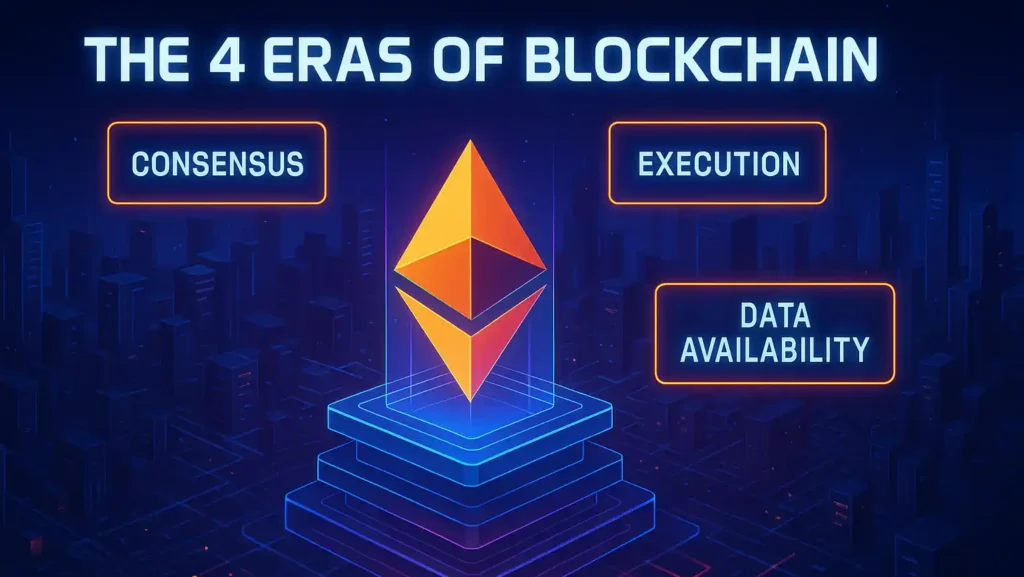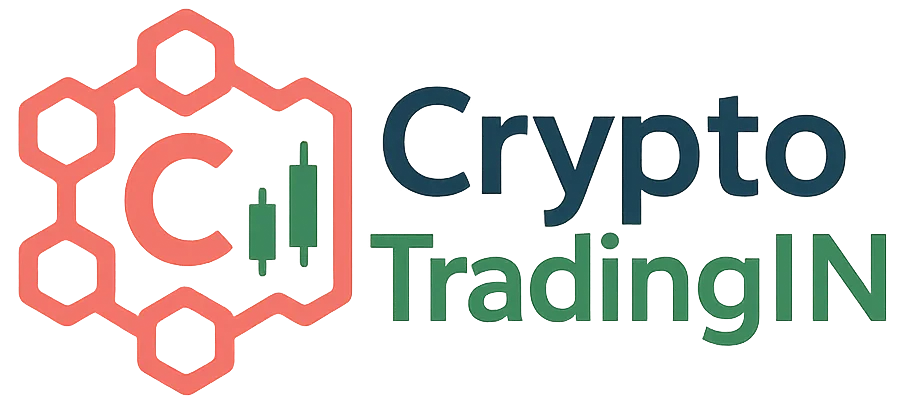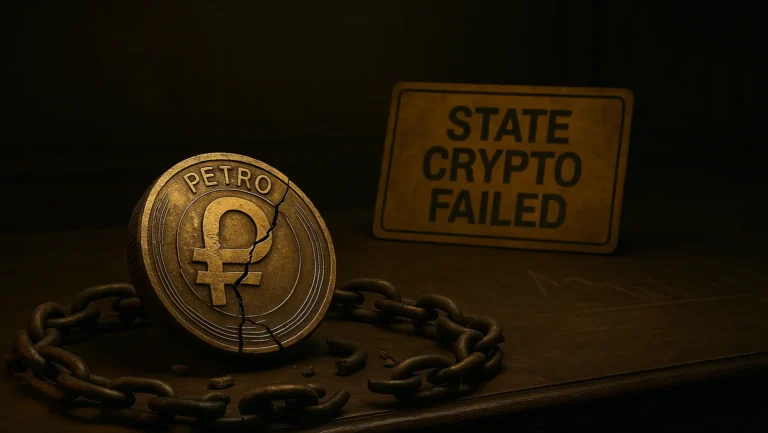The 4 Blockchain Eras: Ethereum’s Modular Revolution
The Four Blockchain Eras: How Ethereum Became the Internet’s Trust Engine

In the early days of crypto, the question was simple: “Which blockchain will win?” A decade later, we have a very different question- “How do we design an open, secure, and scalable internet of value?”
The answer lies in understanding the four major eras of blockchain architecture each one building on the last, leading us to a radically new model- Ethereum as the universal trust layer.
Let’s walk through these eras, the breakthroughs they enabled, and why today’s modular blockchain stack is more than just a technical upgrade it’s a redefinition of how decentralized systems coordinate, scale, and grow.
Era 1: Monolithic Chains – The One Chain to Rule Them All Mindset
In the beginning, blockchains were monolithic. Think of Bitcoin and early Ethereum. Each chain had to do everything by itself
- Consensus: agreeing on the truth.
- Execution: processing smart contracts or transactions.
- Data availability: making sure transaction data is visible to all.
This “all-in-one” approach made sense in the early days. Bitcoin focused only on payments, while Ethereum introduced general-purpose smart contracts.
But this architecture had serious limitations. Scaling meant pushing everything harder, like asking a single machine to handle more and more tasks. Eventually, monolithic chains hit performance and flexibility ceilings.
The ecosystem became a battleground. People debated whether Bitcoin or Ethereum, or a new chain, would win. It was a winner-takes-all mindset.
Era 2: Multi Chain Dreams – Let 100 Blockchains Bloom
As the crypto space matured, developers realized that maybe we didn’t need one chain to do everything. Why not have multiple blockchains, each optimized for different things?
Enter the multi-chain thesis.
This era saw the rise of “Alt-L1s” like Solana, Avalanche, Near, and Polkadot, all offering alternative designs and performance benefits. At the same time, interoperability protocols like Cosmos (IBC) and Polkadot (parachains) emerged, aiming to connect these fragmented networks.
The vision was a decentralized internet made up of many specialized blockchains, all linked together by cross-chain bridges.
In practice, however, this vision ran into trouble:
- Security: Bridges were often weak points and frequent targets of attacks.
- Liquidity: Assets got fragmented across ecosystems, weakening DeFi and user experience.
- Network effects: Instead of compounding value, fragmentation diluted it.
The dream of seamless multi chain interoperability remained attractive, but the reality was messier.
Read: What Is Going On With Crypto Today
Era 3: Rollup Centric Ethereum – The First Step Toward Modularity
To solve the scaling problem without fragmenting the ecosystem, Ethereum introduced a new model: rollups.
In this rollup-centric design, Ethereum would handle the hard stuff security and settlement while execution moved to independent rollups like Optimism, Arbitrum, zkSync, and Starknet.
Think of rollups as fast highways that ultimately report their results back to Ethereum for finality. This allowed for:
- Much higher throughput
- Lower fees
- Shared security with Ethereum
This was the first step toward modular blockchains, where different parts of the stack could evolve independently.
Ethereum was not just a smart contract platform anymore. It was becoming a coordination layer for many external systems.
Era 4: Full Modularity – Ethereum Becomes a Global Trust Engine
We are now in the fourth era, a radical leap from modularity to full decoupling and recomposability.
Thanks to innovations like EigenLayer, Ethereum can now export its consensus to other protocols. This means any system, rollups, data availability layers, bridges, or even decentralized AI agents, can tap into Ethereum’s security model without being part of Ethereum directly.
This is a paradigm shift.
Instead of just scaling Ethereum, we’re building an entire ecosystem around it, where:
- Consensus, execution, and data availability are each provided by different players.
- Ethereum becomes the universal source of truth for all decentralized applications.
This is what some call the hyper-modular blockchain stack.
The New Stack: Hyper Modular, Interoperable, and Open
Here is what the modern blockchain infrastructure looks like:
Consensus as a Service
- Ethereum’s validator set becomes a commodity.
- Via restaking (e.g. through EigenLayer), other protocols can rent Ethereum’s trust.
- Bridges, oracles, AVSs (Autonomous Verifiable Services), and even entire chains can inherit Ethereum-grade security.
Proliferation of Execution Layers
- Rollups continue to evolve, both optimistic and ZK-based.
- We see specialized execution environments tailored to games, finance, social, and AI.
- They run independently but anchor their security to Ethereum.
Dedicated Data Availability Layers
- Projects like EigenDA or Celestia offer scalable, cheaper DA layers.
- These can themselves rely on Ethereum for consensus, forming a recursive trust model.
Why This Architecture Matters
Composable by Default
Unlike Web2 platforms that wall off users and data, Ethereum provides a neutral ground. Any two systems that settle on Ethereum can interact securely without needing to trust each other.
No mergers. No lock-ins. Just pure cryptographic interoperability.
Permissionless Scaling
New capacity doesn’t require a core team or protocol upgrade. Anyone can spin up new execution environments, data layers, or AVSs without permission, as long as they pay to secure themselves with ETH.
The system grows organically more users bring more validators, which brings more services, which lowers costs, which brings more users.
It’s an economic flywheel built on open infrastructure.
The ETH Token: From Gas to Meta-Security
In this model, ETH becomes more than just gas. It is now:
- A deflationary asset
- A settlement currency
- And a productive capital asset, thanks to restaking revenue.
Protocols pay ETH stakers to access Ethereum’s security just like apps might pay AWS for uptime. But here, the value flows back to ETH holders, not a centralized provider.
ETH becomes the economic foundation of web3’s security-as-a-service model.
Proof It’s Already Happening
This is not just theory. Let’s look at the data.
| Metric | Value (as of mid-2025) |
|---|---|
| Restaked ETH | ~$11 billion TVL (~4.6 million ETH) via EigenLayer |
| Autonomous Verifiable Services (AVSs) | 40 live AVSs, 160+ in development |
| Rollups | 129 live rollups with over $42 billion in TVL |
| Performance Example | MegaETH: 130M+ tx/day, sub-cent fees, runs on hobbyist hardware |
We’re seeing Web2-level performance, but with Web3’s openness, decentralization, and composability.
A New Foundation for the Digital World
Ethereum is no longer just competing with other blockchains. It is redefining the stack that underlies the internet itself.
- Instead of centralized platforms like AWS or Google Cloud, you get trust-minimized infrastructure anyone can use.
- Instead of proprietary APIs, you get public cryptographic commitments.
- Instead of one company owning the network, you get a decentralized validator set securing everything.
Ethereum becomes the coordination layer for AI, financial systems, DAOs, and digital identity, the base protocol for the next internet.
Conclusion
The future of blockchains is not just about faster transactions or cheaper fees. It is about building systems where trust is infrastructure, not an app feature.
Modular Ethereum architecture enables this by:
- Making trust exportable,
- Scaling in a permissionless way,
- And keeping value aligned with the community, not corporations.
We are not watching the evolution of a single blockchain anymore we were witnessing the birth of a decentralized, composable, and scalable internet with Ethereum as its heartbeat.






